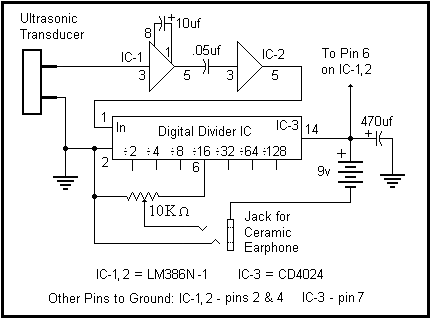Construction is straight forward and can be laid out very much as the schematic shows.
Heterodyne bat detector schematic.
This was first presented by popular electronics magazine as an ultrasound detector in 1994.
Hand held or passive and type of technology heterodyne fixed frequency time expansion or full spectrum.
There are other types of detectors which record bat calls so that they can be analysed afterward but these are more commonly referred to by their particular function.
Bat detector choices are influenced by factors such as your experience the mode of operation that you want e g.
This bat detector is a heterodyne design.
Build a semiprofessional bat detector with the teensy 3 6 microcontroller teensy audio board for less than 100 i developed this bat detector in the hope that it will promote the study of bat calls by everyone who is interested in the natural history and bioacoustics of bats and or interested in the technical details of how the detection.
A bat detector is a device used to detect the presence of bats by converting their echolocation ultrasound signals as they are emitted by the bats to audible frequencies usually about 120 hz to 15 khz.
Heterodyne detectors are the most commonly used and most self build detectors are of this type.
A bat detector uses a special microphone to capture these high frequency.
This project is about building a so called bat detector i e.
Nevertheless the sounds heard with this detector are highly informative with real scientific value.
These sounds lie in a frequency range above the human audible range and thus can t be heard directly.
As you probably know bats emit ultrasonic sounds for the purpose of echolocation.
A heterodyne bat detector simply shifts all the ultrasound frequencies downwards by a fixed amount so we can hear them.
This is a schematic for a straightforward direct conversion heterodyne detector having a tuning range of about 10 khz to 120 khz.
This means that realistic sounding calls are heard but bear in mind that they have been frequency shifted and are representative artifacts of the original sounds.
From popular electronics 1994 the circuit shown here is for a heterodyne bat detector.
Schematic of a heterodyne bat detector.
It has been optimised for the use of an electret microphone.
Click image for a larger jpeg view.
The by far most popular method for bat detectors appears to be the heterodyne down converting if you judge by the number of commercial and home built circuits frequency compression or time lapse this is the most advanced technology based on digital signal processing of the sampled bat sounds but it also requires the most advanced electronics.
A device that lets you listen to and record the sounds emitted by bats.

